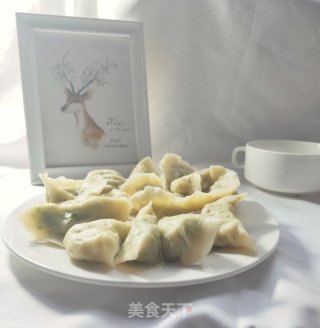Three Fresh Dumplings
1.
Pour four bowls of flour into the basin, pour in an appropriate amount of water and knead into a smooth dough, cover with plastic wrap, and let it stand for 15-20 minutes.
2.
Pick and wash the bought leeks, control the moisture, put the fungus in a basin and add cold water to soak in advance.
3.
Knock 8 eggs into the bowl, stir quickly with chopsticks.
4.
Pour an appropriate amount of oil into the pot to heat, pour in the egg mixture, stir-fry quickly and let cool for later use.
5.
Finely chop the washed leeks, chop the soaked fungus into thin strips and pour into the egg pan.
6.
Pour a small amount of oil into the pot, stir evenly with 1.5 teaspoons of oil consumption, add 2 teaspoons of salt and stir again.
7.
The proofed dough is evenly cut into 3 pieces with a knife. Take one of them and knead it with your hands like a steamed bun to remove excess air from the dough.
8.
Knead the kneaded dough into strips about 3 cm wide and cut into 1 cm thick pieces with a kitchen knife. Sprinkle an appropriate amount of flour evenly on the agent for later use.
9.
Use a rolling pin to roll the cut agent into a thick dumpling wrapper with a thin edge in the middle and set aside.
10.
Take a rolled dumpling wrapper, put the adjusted filling on the dumpling wrapper with chopsticks, fold it in half and close it.
11.
Pour proper amount of water into the pot and bring to a boil. Put the dumplings one by one into the boiling water and boil over high heat. Turn to low heat until the skins of the dumplings are bulging, remove the dried water and put them on the plate.


Tips:
1. Do not add salt to the leek stuffing before making dumplings, otherwise it is easy to kill the excess water and it will not be good to make dumplings and it will also affect the taste of the stuffing.
2. Put some cooking oil before adding salt, which can lock the moisture of the leeks and prevent the excessive moisture from adding salt, and it tastes delicious.
3. While adding water to the flour, stir the flour by hand until the flour becomes a snowflake shape and start to knead the dough until it becomes hand-bathed and dough-bright, commonly known as "Sanguang".
4. Novices are forbidden to add a lot of water at one time when kneading noodles, and knead the noodles while adding a little bit of water.
5. The ratio of flour to water is generally 1:1.2.
6. Those who don't know how to knead can go to the supermarket or pasta shop to buy ready-made dumpling wrappers and make their own fillings.